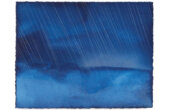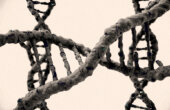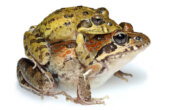Sperm Wars and False Penises: The Bizarre Sex Lives of Insects
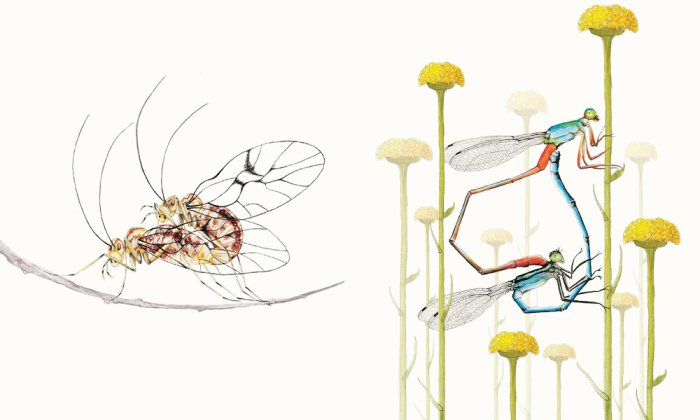
There may be nothing unnatural in nature, but nature still encompasses much that seems fantastically strange — the amazingly multifarious sex lives of animals, for example. Emmanuelle Pouydebat’s “Sexus Animalis,” from which the following text is excerpted, tells us everything we never dreamed we wanted to know about the reproductive systems, genital organs, and sexual practices of animals, from elephants (who masturbate with their trunks) to fruit flies (who produce spermatozoa 20 times their size) to bark lice (whose females penetrate the males — see below). In the animal kingdom we find heterosexual, lesbian, gay, and bisexual behavior, as well as monogamy, polygamy, and polyandry, not to mention fellatio and many varieties of erections and orgasms.
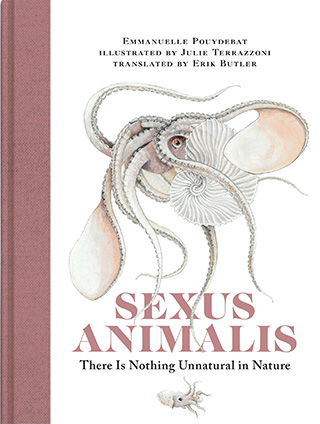
Pouydebat, a natural history researcher, tells us about gutter penises, double penises, detachable penises, and corkscrew-shaped penises, as well as vaginas built for storage and clitorises with thorns. (Perhaps unsurprisingly, there’s more data about animal penises than animal vaginas and clitorises.) She explains how the ostrich achieves an erection, describes the courtship of pygmy chameleons, and recounts how the female short-beaked echidna chooses a partner. Indeed, “over the course of this book, human organs and sexuality come to look pretty humdrum,” writes Pouydebat. “The animal world has beat us on every score.”
BARKLICE (neotrogla sp.)
We’ve already seen how females of Nicrophorus vespilloides chemically castrate males to make them monogamous. The barklice of the Neotrogla genus use an even more radical strategy. And you thought it couldn’t be done.
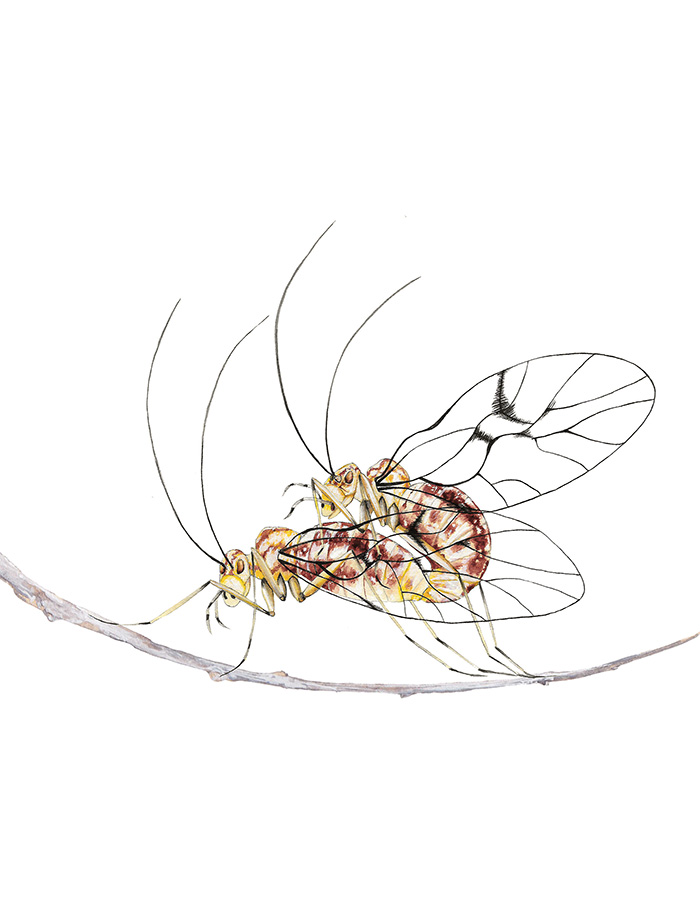
These barklice are tiny flies about three millimeters long. They live in dry caves in Brazil, where they seem to feed on guano and bat carcasses. Nothing very exceptional. But here it comes. This is a unique case (who knows, maybe others will be found) of sexual inversion. That’s right: the genital organs of males and females work the other way around. We know all about males penetrating females, but here the females pierce the males. You couldn’t ask for a more complete sexual revolution.
So what does all this look like? It’s pretty simple: Females have a kind of false penis, known as a gynosome, which enters the male’s body. Is the point to hurt him? Not at all — it’s to get nutrients and sperm! There’s nothing as reliable as doing the job on your own. And in so doing, Ms. Barklouse takes her sweet time: Mating goes on for a period between 40 and 70 hours! That’s what it takes for the female to assume a position on top of the male, insert her gynosome, and let the swollen organ hang there anchored by spines in the male’s genitals. To get an idea, know that her false penis sits so firmly that if you try to unhook her, the male’s abdomen will rip right off. Nutrients obtained by this means are vital for her to conceive eggs. Such behavior might have developed because the caves where these barklice dwell offer scant resources. If so, this is a way of killing two birds with one stone, so to speak. Just consider the males as sperm banks and refrigerators in one. That’s really turning the tables!
Ms. Barklouse takes her sweet time: Mating goes on for a period between 40 and 70 hours!
Is anything like this known to happen elsewhere? When it comes to consuming resources that belong to the male, other examples exist, which are just as spectacular — if not more so. For instance, the female sagebush cricket (Cyphoderris strepitans) eats her partner’s fleshy wings in the process of mating. But the Palme d’Or probably goes to mosquitoes of the Heleidae (Ceratopogonidae) family. When mating, the female simply pierces her partner’s head with the pincers on her mouth. By this means, she can inject digestive juices so that his body will dissolve before she devours it. Incredible. . . . Then she throws away his empty shell, keeping only the genitals (which are now attached to her) for fertilization. It bears repeating: She liquefies her partner, gulps him down, then keeps his stuff for herself. That’s really something else.
DAMSELFLY (Zygoptera sp.)
“Damselfly”. . . . What a pretty little name. It might be charming, but it conceals unexpected cruelty. Among many insects, the morphology of the penis is perfectly matched to the internal anatomy of the female’s genitals. Unfortunately, this doesn’t prevent males from expressing themselves to the detriment of their partners. Gentlemen damselflies — like dragonflies, their close relative — exhibit astonishing anatomical particularities.
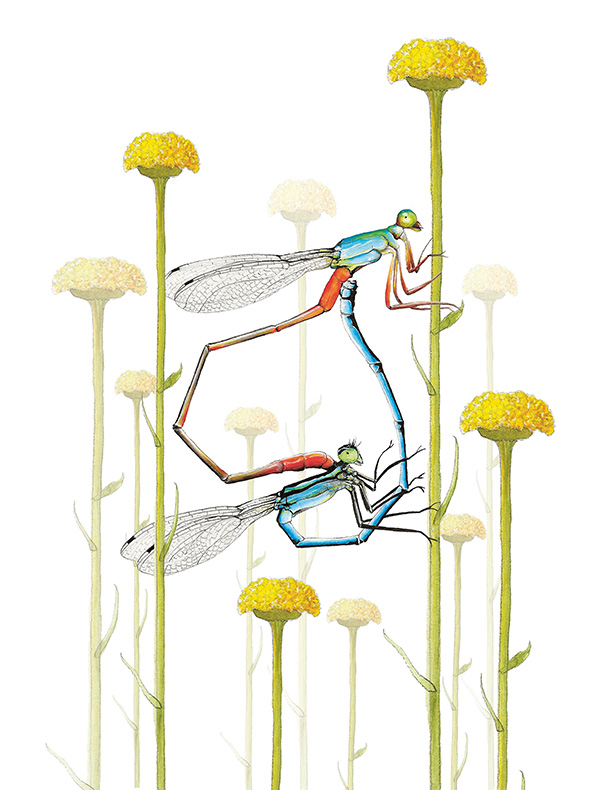
To appreciate just what is happening, it’s important to understand the act of mating itself. Most of the time, the male straddles the female, and sometimes the female rides on top of the male. But any number of other positions can be assumed in keeping with anatomical constraints. What’s remarkable about damselflies is that they produce sperm at one end of the abdomen, while their copulating organ is located at its base. Hardly a practical design. To remedy the situation, the male, prior to mating, bends his body in order to fill up the reservoir that is part of his reproductive apparatus with sperm. During the act itself, he grabs his partner between his head and thorax by means of the pincer at the end of his abdomen. Difficulties don’t stop here, though. The female’s genital opening is at the end of her abdomen, so she needs to bend forward for contact with the penis to work. Damselflies form a heart-shaped figure when mating! That might sound poetic, but things get pretty ugly. . . .
The competition’s tough. When damselflies set about reproducing, a whole gang of males gather at places suitable for laying eggs. Very few of them will manage to mate with a female. What’s more — and as is the case with other arthropods and mollusks — lady damselflies are endowed with a spermatheca and can hook up with several partners, then save the sperm for fertilizing eggs later on. While this might seem like a boon for the female, it poses a danger for males, whose sperm can get crowded out by somebody else’s.
When the female is, ahem, busy, the male is busy scraping out between 90 and 100 percent of the sperm left by his predecessor.
Consequently, male damselflies have a strategy of their own for optimizing the transmission of their genes. Evolution has equipped them with a reproductive organ — the aedeagus, to be technical — that’s shaped like a spoon. That’s right. And the male uses this mighty appendage, a veritable work of art, as a scraper to remove the sperm of his predecessors. Some dragonflies even have thorns, bristles, or other barbs on their organ. So for a few minutes when the female is, ahem, busy, the male is busy scraping out between 90 and 100 percent of the sperm left by his predecessor. Then, in just a few seconds, he makes his own deposit in the sperm bank. Whoever does so last basically gets to be the proud father. Kicking out rival sperm to ensure the greatest chance of fertilization — somebody was bound to do it.
To conclude our discussion of the matter, note that suppressing rival sperm can also occur by chemical means. Some mosquitoes have a substance in their semen that will act to expel sperm that is added later. By the same token, but in reverse, some members of Drosophila have sperm that will drive out what rivals have already left behind.
Emmanuelle Pouydebat is a permanent researcher employed by the CNRS (French National Center for Scientific Research), working at the Muséum National d’Histoire Naturelle in Paris. She is the author of “Atlas of Poetic Zoology” and “Sexus Animalis,” from which this article is excerpted.
